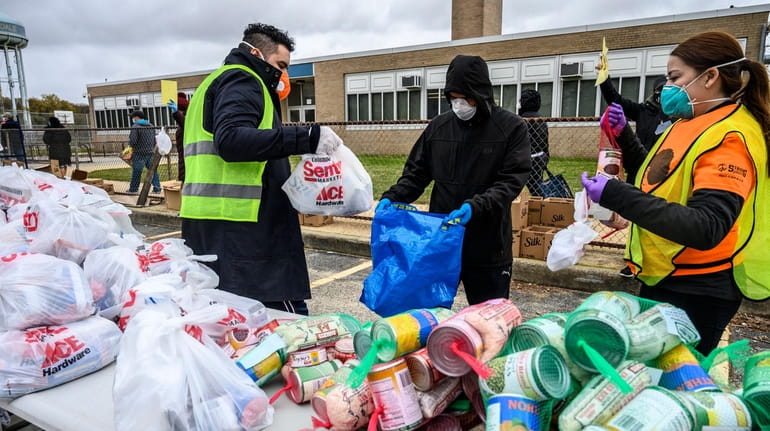Food supply chain at the breaking point

More than 1,000 families in Uniondale Union Free School District received meals during a drive-through food distribution bank at Turtle Hook Middle School on Monday. The initiative is part of a partnership between Uniondale School District Staff, Nassau County and Island Harvest in efforts to help the growing number of Long Island residents who were furloughed or lost their jobs and are struggling with food insecurity due to COVID-19. Credit: Newsday/Alejandra Villa Loarca
Some of the more jarring sights marking this coronavirus pandemic have centered on food.
Images of dairies flushing milk down drains and farmers plowing under produce in fields have been juxtaposed with lines of cars seeking help from food banks — a bewildering tableau of plenty and scarcity. Meat processing plants in rural communities have closed as unprotected workers became infected in coronavirus outbreaks; 25% of pork production is now offline and millions of chickens and pigs face slaughter because not enough plants are open to process them for market. The severity of the problem led to President Donald Trump’s plan Tuesday to order that meat processing plants remain open during the pandemic.
The picture is of an inflexible food supply chain strained to the point of breaking.
It’s a difficult and complex problem but, fortunately, not an unsolvable one. It requires ingenuity, urgency, better logistics, and government funding now, and advance planning to be ready when the next pandemic arrives.
For food producers, the problem is a lack of options. Some upstate dairies, for example, produce single-use milk boxes for schools, not gallon containers for homes. Industrial farms in California and Florida sell to big institutional buyers like restaurants and hotels, and are not prepared to do family-size packaging. When schools and restaurants closed, those business models were fractured.
For consumers, some shortages have been evident on store shelves. For others, scarcity is made worse as job losses mean many can’t afford to buy food. Demand for help from food banks has increased 70% nationally, and 40% on Long Island. One local group, Island Harvest, served 1,300 families in Hempstead last week and 850 families in Uniondale on Monday, giving each a week’s supply of foods like spaghetti, beans, vegetables and fruit.
This week, Gov. Andrew M. Cuomo announced $25 million in emergency funding for food banks and a plan to join with New York dairy producers to process some of that excess milk into yogurt, cheese, sour cream and cream cheese to be distributed to food banks and those in need. That will help. So will $3 billion the federal government recently committed to purchase fresh produce, dairy and meat for nonprofits serving hungry Americans. Still, local food banks need donations and money from the rest of us.
The federal government, late to react to the food crisis, must work with meat processing plants to get more protective equipment for workers, clean shared equipment, and reconfigure workstations so that physical barriers create at least six feet of space between them. Farming operations should be more nimble when markets change. Local food banks, which banded together after superstorm Sandy to improve their response to disasters, must do the same for pandemics.
We can do this. We have enough food. We need to be smarter and better prepared so it’s not wasted and gets to those who need it.
— The editorial board
